Serviços Personalizados
Artigo
Indicadores
Links relacionados
-
 Citado por Google
Citado por Google -
 Similares em Google
Similares em Google
Compartilhar
Koers
versão On-line ISSN 2304-8557
versão impressa ISSN 0023-270X
Koers (Online) vol.87 no.1 Pretoria 2022
http://dx.doi.org/10.19108/KOERS.87.1.2514
ORIGINAL RESEARCH
The Push and Pull Factors of Teaching as a Profession - the Perceptions and Expectations of Student Teachers
Gladys Mankoana Sibanda
Educational Foundation Department Faculty Of Humanities, Tshwane University Of Technology https://orcid.org/0000-0001-9044-7989
ABSTRACT
Research has shown that despite the teaching profession being labelled an unattractive career, student teachers' enrolment in South Africa continues to rise annually. This study seeks to investigate why student teachers enrol for teaching in South Africa today. 222 first year student teachers enrolled for education in a South African university participated in the study, which looked at the perceptions and expectations of student teachers in South Africa. A 91-item questionnaire was used to collect data, and the results indicate that these student teachers have more positive perceptions and expectations on the teaching profession than expected. The study recommends improvements in the education and training environment in South Africa in the form of introducing tax relief measures for teachers; intensified capacity building, and skilling of educators; re-imagining educators' professional identity through improved professional virtue; improving safety and security in schooling environments; lessening what the author regard as pure administrative functions of teachers which add to the teaching workload; and having in place effective and sustainable infrastructure development programmes.
Keywords: student teachers, perceptions, expectations, teaching, professionalism
1. Introduction and Background
The teaching profession plays an important role in the literacy of all members of society. Equally important is the role played by the South African institutions of higher learning (IHLs) including universities and colleges in the education of student teachers. As custodians to the profession, IHLs are uniquely positioned to provide access to education training. In 2010 the Council on Higher Education (CHE) reported an increase in the enrolment of student teachers in IHLs. This is despite some research reporting that South Africa faces a challenge of teacher attrition, with some teachers leaving the profession within five years of entering the profession for various reasons (Department of Education, 2005, Robinson, 2003 & 2005, Human Sciences Research Council (HRSC), 2005 Report & Wolhuter, van der Walt, Potgieter, Meyer & Mamiala, 2012).
The study specifically investigates the reasons for an increment in the enrolment of student teachers in institutions of higher learning. In particular, the study seeks to establish the perceptions and expectations of student teachers of the teaching profession. Furthermore, this study seeks to answer the question: What are the motivations for student teachers for choosing the teaching profession in South Africa? Many studies exist generally discuss the motivation for the choice of teaching as a professional career (Stokes, 2007; Krečič & Grmek, 2005; Jantzen, 1981 and Brown, 1992). However, there have not been many studies examining specifically the motives of students registering for teaching in South Africa amid many indications that teaching may not be an attractive career choice.
It must be noted that there are numerous factors that can be considered for and against enrolment in the teaching profession. Thus, this study does not propose to address all the possible factors. Some of these factors are addressed in existing literature. The focus of this study is on what inspires student teachers to train for and join the teaching profession in SA today. It also considers what is considered as de-motivators for joining the teaching profession. In brief, the study investigates the "push and pull factors" of the teaching profession in South Africa today. Also, it must be noted that, like in every project, some limitations were encountered which do not suggest that this study is not relevant or necessary. In particular, the study was undertaken at one university in the form of a research questionnaire with participants being predominantly black which could render the findings biased based only on one race. Despite the limitation(s), the author believes that the findings of this study partially revealed how students perceive the teaching profession and what they expect from the profession.
To contextualize the enquiry into the motivators for student teachers joining the profession, an overview of data collection procedures and the methodology used has been discussed. Then follows the presentation of the findings and the analysis of the data and discussions. Data analysis and presentation is in a tabular form answering questionnaire items, which is followed by the section on the interpretation and analysis of the data. Study recommendations are also provided and then findings and discussions. The study identified and elucidated the following recommendations, improvement in the education and training environment in South Africa in the form of intensified capacity building, and skilling of educators; re-imagining educators' professional identity through improved professional virtue; improving safety and security in schooling environments; lessening what the author regards as pure administrative functions of teachers which add to the teaching workload; and having in place effective and sustainable infrastructure development programmes.
2. Literature Review
2.1 Factors dissuading student teachers from enrolling as education students
It is appropriate to discuss the status of the teaching profession in South Africa before discussing in depth some factors that dissuade student teachers from enrolling as education students. From the literature review, it is evident that teaching as a career is viewed from different perspectives and that different scholars express different opinions. The teaching profession is facing sporadic drops and pick-ups in levels of interest.
2.1.1Negative publicity and representation of teachers' work.
Numerous negative publicity and media reports on teachers' work and the profession in general paint an adverse view of the profession. These reports come through different channels, including mass media. One particular often-publicised factor is the lack of security at schools. Both teachers and learners are negatively affected by the insecurity and lack of safety of the school environment (Oosthuizen, 2004: 2). Oosthuizen (2004: 2) further observes that "successful educational teaching can only take place where there is security". The potential vulnerability of teachers as a result of an insecure educational environment may be dissuading students from joining the teaching profession.
2.1.2Shifts towards the profession in public opinion
Public opinion about the profession is related to the culture of learning and teaching (COLT) of teachers and learners. COLT explains that the "attitudes of teachers and learners towards learning and teaching (Heystek & Lethoko, 2001: 222) is influenced by many factors, including trade unionism. However, the increasingly politicised nature and direction of the teacher trade unions has been a factor of concern; and it is becoming a factor dissuading aspirant teachers whose interests is only in the social welfare of learners and imparting knowledge and information from seriously considering the profession. The unions' industrial actions include strikes, chalk-downs, class boycotts and sit-ins by teachers. These play a role in dissuading students from joining the profession, particularly considering the negative publicity attracted by the profession.
2.1.3 Growing sizes of classes and workload, remuneration and unpleasant working conditions.
The growing sizes of classes and workload that are not synchronised with the salary and benefits of teachers may become dissuaders to joining the profession (Lumadi, 2008:11) and can also create despondency among novice teachers accompanied by "fear, anxiety, stress and feelings of inadequacy" (Steyn, 2004: 87). According to Bull (2005: 14) work overload has been "interpreted as endemic of dissatisfaction within the profession". Unpleasant working conditions, including overcrowding of classrooms, for example, "impact negatively on the creation of a sound culture of teaching and learning (Zulu, Van der Merwe, & Van der Walt, 2004: 170)
2.2 Factors that motivate student teachers to choose teaching as a career
Decisions concerning career selection and choice as one of the most important choices by learners nearing the end of their schooling (Akintomide & Oluwatusin, 2011: 116). These decisions are not taken lightly, and can be influenced by many factors, which can be extrinsic, intrinsic, or altruistic (Akintomide & Oluwatusin, 2011: 116). London (1983: 620) provides a comprehensive definition of career motivation as "the set of individual characteristics and associated career decisions and behaviours that reflect the person's identity, insight into factors affecting his or her career, and resilience in the face of unfavourable career conditions".
Evans (1993:33) and Thomas (1984: 47) are also of the opinion that some students teachers are attracted to teaching because, they harbour the desire to correct and improve the lives of many people and of their communities and also to work in an environment that is traditionally highly respected and that allows them the autonomy to express and/or demonstrate their creative abilities.
3. Data Collection and Methodology
This study was designed to be deductive, descriptive and empirical premised on the theories and quantitative evidence. This study employed a quantitative approach which "emanated from a positivist approach", to borrow from the words of Cohen, Manion, & Morrison (2007). Data collection was done with the use of a questionnaire administered to first year students enrolled for educational studies at a university in South Africa. The literature review (including research studies, books and newspapers) was pivotal in structuring and developing the questionnaire. The Statistical Package for the Social Sciences (SPSS) was used to analyse data in order to elicit statistical information.
The author distributed the questionnaires to student teachers enrolled in educational studies at a South African university. A total of 222 male and female first year student teachers enrolled for educational studies were selected as the sample of this study. Student teachers who participated in the study were aged between 17 to 24 years and above. The participants of the study were 99% black and 1% coloured. This is due to the geographical location of the university. Data was collected during the first quarter of the first semester.
The construction of the questionnaire was aided by the literature study and the authors' experience as former teachers. The construction of the questionnaire enabled all participants to answer the same questions and also choose answers from a list of answers provided. The questionnaire was drafted in such a way that participants' names, identity numbers and/or addresses were not required. However, it is important to note that participants' race was required only for statistical purposes and nothing else (this was made clear in the questionnaire). In addition to race, biographical and demographical information included gender, age, home language, course specification, highest qualification, and who was paying for their studies was included.
The construction of the questionnaire was done in such a way that the author would be able to elicit information on why participants chose to become a teacher, their perceptions of the teaching profession, and their expectations of the teaching profession and lastly, factors that might have dissuaded them from choosing to become a teacher. The questionnaire was a four-item Likert-type scale with 91 statements. The language of the questionnaire was English. The participants were asked to choose only one of the four choices listed as: Strongly Agree, Agree, Disagree, and Strongly Disagree.
4. Data analysis and discussion
4.1 Biographical data
Table 4.1.1 above indicates that participants are predominantly male with 64.4% whilst their female counterparts recorded a mere 35.6%. These results are a complete contradiction of the assumption that teaching is a profession for females. It also implies that more men have made a conscious decision to join teaching, for various reasons, as revealed by this study.

4.2 Factors that encouraged you to enrol as education students
The data above in Table 4.2.1 illustrates that most students sampled (95.95%) entered teaching because of their interest in the profession. This may augur well for the retention of teachers in the profession and account for low attrition. Less than 5% of the students are not interested in the teaching profession. This could mean that this low number of students was unsure of their decisions of joining the teaching profession. Those who disagree could represent a group of those teachers who leave the teaching profession within five years after joining it (Robinson, 2003 & 2005).

Table 4.2.2 indicates that a significant number (79.28%) of participants strongly agree that teaching offers a reasonable assurance of an adequate income while 20.72% disagree. These percentages resonate well with the findings in Table E below whereby 82.43 students agree that teaching will provide a reliable income. 17.57% of the participants responded negatively. Participants seem optimistic about their prospective career, and they joined it with a positive frame of mind. Another observation could be that those who agreed that teaching offers a reasonable assurance of an adequate income and that it provides a reliable income, did so because of their geographical background. The percentages of those who disagreed are 20.72% and 17.57% in Tables 4.3.2 are not insignificant. It is possible that they represent teachers who joined teaching as their last resort.
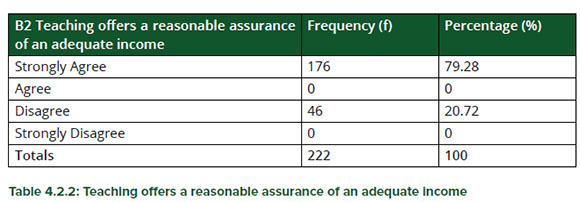
Data contained in Table 4.2.3 indicates that a large percentage of participants (91.44%) chose the teaching career expecting possibilities of advancement within the profession. The students may not be aware of the fact that the possibility of advancement is strongly linked to self-development and continuous learning by teachers to empower themselves. Those who disagree constitute 8.56%. This percentage could represent a group of student teachers who do not care much about self-development and continuous learning. But this may change once they become teachers and realise the benefits that come with promotions.
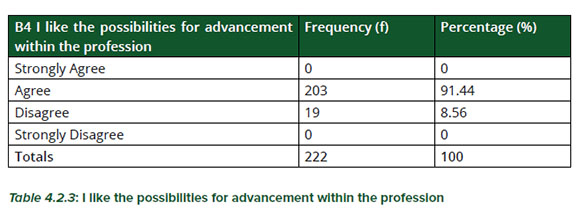
Table 4.2.4 clearly shows that a small percentage of students (17.12) disagree that they joined teaching because of the reported ease of getting a teaching position. One would like to think that this group joined teaching for altruistic reasons and not because it is easy to get a teaching post. This group constitutes student teachers who could remain dedicated to the profession because they were sure of their choice of becoming teachers. A large percentage of participants (82.88) strongly agree that they chose to become teachers because of the reported ease of getting a teaching position. One could argue that this group constitutes teachers who join teaching as a stepping-stone to other professions. The implication is that these participants may not contribute positively towards teaching and learning once they become teachers.
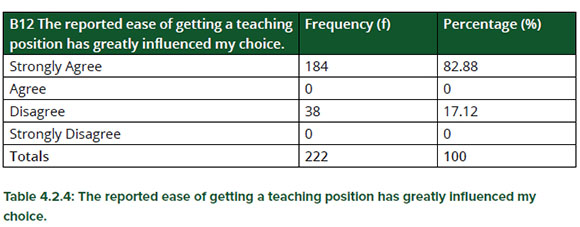
The Table 4.2.5 above indicates that most students (91.44%) chose teaching because they like teaching and that they want to become teachers as compared to 8.56% who responded negatively. The high percentage of the participants could represent those teachers who will remain and contribute significantly to the teaching profession.

There are negative media reports on the teaching profession that may have adverse results on prospective teachers' choice of joining the profession. On the contrary, Table 4.2.6 above indicates that this view may not be true as 85.14% of the participants agree that the ethics of the profession has been a deciding factor in enrolling for teaching. This group constitutes student teachers who, despite the negative publicity, were driven and motivated by their passion for teaching that they decided to join the profession. Furthermore, it could be that the negative publicity of the profession from the media has, unexpectedly, influenced these participants to enrol for teaching in order to make a worthwhile contribution to the society in which they live.
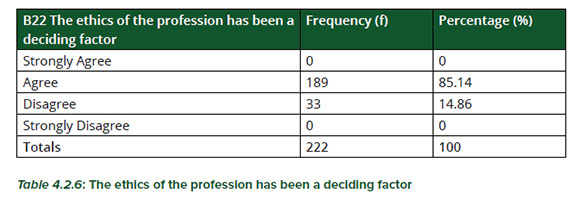

In fact, B22 could be interpreted differently by different participants. Some participants may feel that the profession lacks good ethics, hence the negative responses (14.86%). This group could represent student teachers who viewed the ethics of the teaching profession in a negative way and who, despite the negativity, they still chose to become teachers.
The data contained in Table 4.3.1 above indicates that a mere 6.76% of participants disagree that teaching will be a secure job. One could argue that their choice for becoming teachers was not done with the commitment to teaching as a lifelong career. This group could represent those teachers who leave the teaching profession for other professions they believe would guarantee them job security. However, a significant percentage of student teachers (93.24) strongly agree that teaching will offer them job security. It could be that these participants agree with this view considering their geographical background. For instance, a person who is from a rural area or has a poor background could more easily have become satisfied with becoming a teacher compared to those from the townships and urban areas.
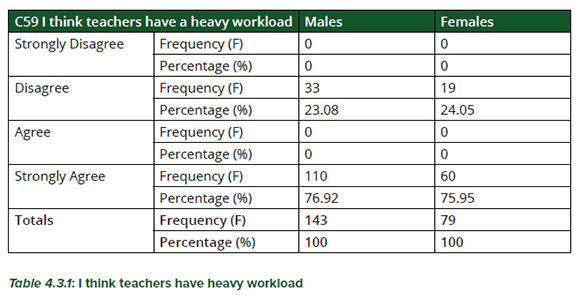
4.3 Student teachers' expectations on the teaching profession per gender
In this section participants were requested to indicate whether they agree or disagree with expected aspects in the teaching profession. This section was also categorised into gender. It is equally important to reiterate that sample consisted of 222 participants (male and female). Table 4.3.1 below indicates responses provided by males and females separately according to the frequency and percentages.
It is interesting to note that almost the same percentage of males (23.08) and females (24.05) disagree that teachers have a heavy workload. This could imply that these participants will experience a reality shock when they finally become teachers and realise that teachers do indeed have a heavy workload. This realisation could result in frustration and dissatisfaction to this group of participants. Frustration and dissatisfaction are undeniably a cause of teacher attrition. Interestingly, large percentages of males (76.92) and females (75.95) strongly agree that teachers have a heavy workload. One can conclude that this group is likely to enter and remain in the teaching profession despite the heavy workload.
Table 4.3.2 above indicates that considerable percentages of males (37.06) and females (43.04) disagree that teachers earn a good salary. This is a clear indication that teachers' salaries are not a great influence in terms of the decision to become a teacher. This could simply mean that student teachers chose teaching as their prospective career merely because of their interest in it other than to earn big salaries. Literature studies also reveal that teacher salaries are not regarded as a motivation to join teaching. A significant number of males (62.94%) agree that teachers earn a good salary; compared to their female counterparts (56.96%). Males are reported to be the ones leaving the profession in droves seeking professions with better salaries and that teaching is reported to be the lowest paying job compared to other professions which poses challenges in the retention of skilled teachers (Roberson et al., 1983).
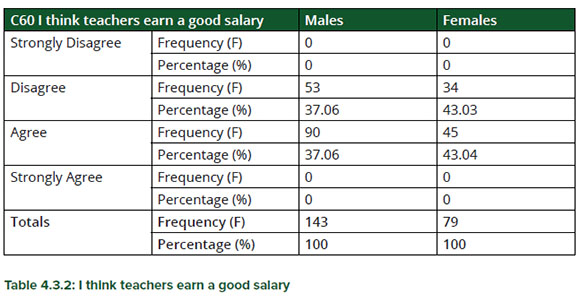
The data in Table 4.3.3 above clearly shows that both males (93.71%) and females (91.14%) view teachers as professionals, whereas small percentages (6.29% and 8.86% males and females respectively) disagree strongly that teachers are viewed as professionals. The fact that the participants in this study see teachers as professionals probably suggests that they will strive to act and behave like professionals once they become teachers. The status of any occupation and/or profession is an important factor when deciding on a career; teaching included. The behaviour of teachers in schools and public areas could be a major influencing factor on someone who intends to join the profession. Therefore, it is imperative that teachers behave in a proper manner in order to preserve the dignity of the teaching profession.
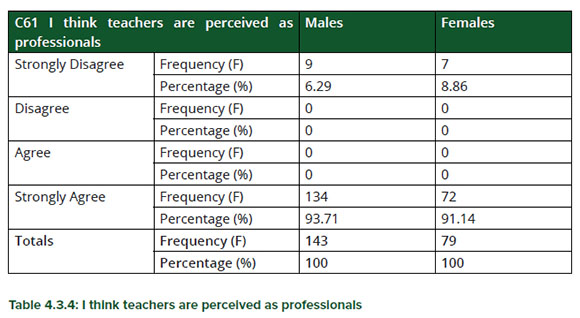
Teaching is one of the professions haunted by a number of challenges, e.g., low pass rates, violence in schools, lack of discipline, lack of resources to name a few. Despite all these challenges, teacher intake has not declined; instead, it grows rapidly year after year Department of Educational, 2000). The statistics in Table 4.3.4 above show that males at 96.50% and females at 83.54% agree that teachers have high morale. On the contrary, studies have reported that teachers' morale and self-esteem has declined due to heavy workload, rapid changes in policies, lack of support (Bull, 2005; Lumadi, 2008 and Zulu et al. 2004), etc. This group could represent teachers who find it difficult to cope with all the challenges experienced in school; subsequently leading them to leave the profession. A miniscule percentage of males (3.50) disagree that teachers have high morale as compared to (16.46) indicated by their female counterparts. This finding could suggest that female participants could have experienced antagonistic behaviour of teachers during their school years as opposed to the male participants.
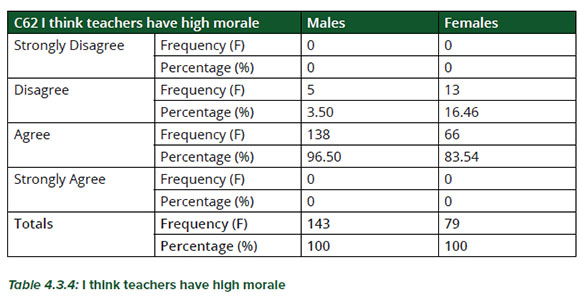
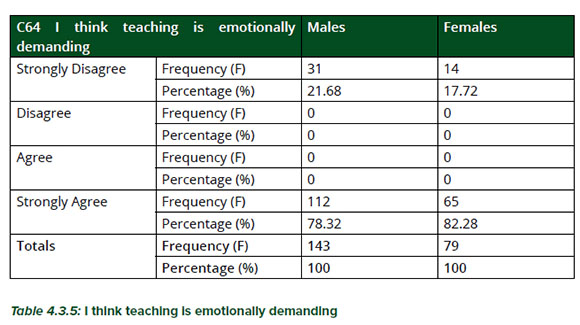
The author, from her experience as a teacher, observed that emotional intelligence is a prerequisite to becoming a good teacher. Teachers with high emotional intelligence are able to cope with challenging situations during their work. Teaching mostly requires teachers who could be able to overcome challenges experienced in their line of work. Teachers are engaged with diverse classrooms with learners from different backgrounds. It is therefore imperative for teachers to exhibit high emotional intelligence. A significant number of male participants (21.68%) do not think that teaching is emotionally demanding as compared to females (17.72%). This could imply that males' emotional intelligence differs from that of their female counterparts.
4.4 Student teachers' expectation of the teaching profession by age-groups.
In this section participants were requested to indicate whether they strongly agree, disagree, agree or strongly agree with expected aspects in the teaching profession. This section is categorised into three age-groups, namely, 17/18 years, 19/20 years and 21 years and above. Categories of age-groups will be referred to as 1, 2 and 3 groups henceforth.
It is evident from Table 4.4.1 above that a large number of participants (127) fall within the age group 19/20 years followed by 62 participants in age-groups 21 & above and finally 33 participants in age group 17/18 years. Amongst all the three groups, 22.05% of the 19/20 years group strongly disagree that teachers have a heavy workload. This is followed by 30.65% and 15.62% within age groups 21+ and 17/18 respectively. On a positive note, percentages of participants 84.38, 77.95 and 69.35 in age groups 1, 2 and 3 agree that teachers have a heavy workload. It is an interesting observation that these percentages are evidently higher than those who indicated otherwise. It is therefore acceptable to expect these participants to manage their work efficiently once they become teachers. The older the participants are, the more likely they are to disagree that teachers have a heavy workload and the younger they are, the more likely they are to agree that teachers have a heavy workload.
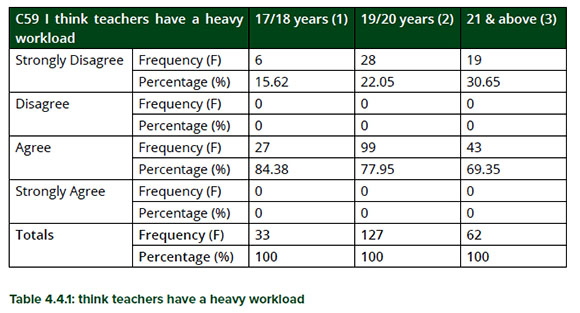
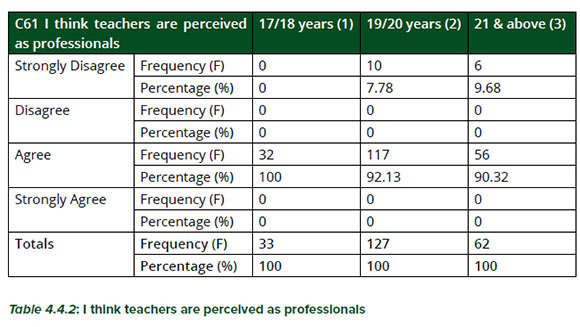
in the third age-group strongly disagree that teachers are perceived as professionals. One could ask why these participants think that teachers are not perceived as professionals. The older the participants, the more likely they are to believe that teachers are not perceived as professionals, and this would suggest a declining degree of optimism about teaching as a career corresponding with the age of the prospective teacher. 100% of the participants in group 1 believe that teachers are viewed as professionals and this number decrease slightly to 90.32% with those who are in group 3 containing the oldest participants.
5. Recommendations
Findings from this study indicated that student teachers chose to become teachers for various reasons. Below are recommendations based on what the author found to be the most critical areas of the findings.
5.1 Intensified capacity building, and skilling of educators
It is recommended that the Department of Basic Education must embark on capacity building and skills improvement and/or transference programmes that are integral to the strengthening and uplifting the teaching profession. This, in the author' view, will support the attraction and retention of the most effective educators and achieve the desired learning outcomes. Professional educators are a critical component of transforming our education system. Also, educators' professional development is an important aspect of a transformative and comprehensive school system reform. This view has been supported by the American Federation of Teachers (2002) stating that "the nation can adopt rigorous standards, set forth a visionary scenario, compile the best research about how students learn, change textbooks and assessment, promote teaching strategies that have been successful with a wide range of students, and change all the other elements involved in systemic reform - but without professional development, school reform and improved achievement for all students will not happen."
For their part, the educator training institutions must prepare professional educators through appropriate professional growth programmes. A word of caution is that the Department must avoid fragmented one size fits all professional development programmes (Redding & Kamm, 1999; Dunn & Dunn, 1998). The professional development of educators must be aligned with curriculum design. However, it must be admitted that the constant changing of South Africa's curriculum design may render achieving this goal difficult.
5.2 Re-Imagining educator's professional identity through improved professional virtue
It is recommended that the Department of Basic Education embark on a holistic drive to re-imagine educator's professional identity through improved professional virtue. The Department can be assisted by teacher unions in achieving the objectives of this recommendation. The nobility of the status of the teaching profession was indicated as one of the issues that will influence entry into the teaching profession. Unfortunately, the profession has experienced a decline in status. Educational International, a global affiliation of teachers' unions and federations constituted in 1993 by a merger between International Federation of Free Trade Unions and World Federation of Teaching Professionals, has been at the forefront of improving professional virtues through, amongst others, a Professional Code of Ethics that seeks to revive and maintains core beliefs about education profession. (Education International, 2002; Education International, 2004; Education International, 2007). According to Sockett (1993), the concept of professional virtue is not only central to the development of the profession. It is also a multi-faceted virtue which many variables including but not limited to demand of accountability, valuing education, servant leadership and servant discharge of professional duties in the service of humanity, and ethical dealing with all stakeholders.
5.3 Addressing safety and insecurity concerns at schools
It is reported in literature studies that violence in schools is a matter with which education systems are struggling and fighting a losing a battle on (Ncube & Harber 2013). Some schools afford to employ security personnel in their schools paid by the school's governing body. However, this effort is not addressing the root of the problem. It is an obligation of the South African government to ensure safety and security in schools. Learners' rights to safe and secure schooling environment are protected in law. In particular, section 28 (1) of the South African Constitution of 1996 states that "every child has the right to be protected from, among others, neglect, abuse or degradation". Also, South Africa as a signatory to the UN Convention of the Rights of the Child is obligated to pass laws and enforce measures to protect the child from all forms of violence, abuse, neglect, maltreatment or exploitation. Equally important is securing the safety of teachers at schools, which finds expression in section 10 of the Constitution stating that everyone, including the teacher, has the right to have his/her dignity respected and protected.
It is recommended that the Department must undertake a comprehensive and holistic review of the current safety measures at schools, including the viability of powers granted to School Governing Bodies (SGBs) relating to safety and discipline in schools. Of concern is whether the SGB is optimally and effectively using powers granted to them, for example, SGBs have the obligation to adopt a code of conduct to establish and promote disciplined, peaceful and purposeful school environment. Yet still, the carrying of dangerous weapons; bullying; harassment; and the use of illegal drugs is reported as daily occurrence at schools. Furthermore, the school principals have the power to take such steps as deemed necessary for safeguarding the school premises, and protection of the people therein pursuant to section 5(1) of the Schools Act.
5.4 Lessen administration work by teachers
It is recommended that educators should be relieved of some of the administration work or be allowed to do less administration work, such as preparing lesson plans. More time should be devoted to teaching and to proper learner assessment procedures. When delegating administrative duties and responsibilities in the school, the school management should take into account teachers' overarching responsibility to teaching and learning.
5.5 Effective and sustainable infrastructure development
Lack of resources such as skilled teachers and teaching materials is behind the removal of children from schools to schools in urban areas (previously known as the Model C schools) because that is where parents believe there are skilled teachers and that these schools are well equipped, resulting into overcrowding. Also, educators may migrate from schools that are perceived as under-resourced to schools deemed fully resourced. Infrastructure is a critical component of transforming the South African education systems, and therefore it is critical to strengthen and elevate the importance of infrastructure development and improvement as a priority area. The Department of Education needs to maintain the necessary infrastructure and resources if the country is to succeed in attracting and retaining the most effective educators and achieve the learning outcomes we seek. Part of this process will be for the build or refurbish school to ease classroom overcrowding, and to ensure that schools in rural areas are equipped with science laboratories. It is notable that the government has a programme called the Accelerated Schools Infrastructure Development Initiative (ASIDI), to eradicate inappropriate infrastructure such as mud schools and addressing backlogs in basic services, for example water and sanitation. However, ASIDI at times has missed its target dates and experienced challenges of lack of proper planning, a fact that has been severely criticized by the Parliamentary Standing Committee on Appropriations.
6. Conclusion
The findings in this study revealed some critical areas that need to be addressed for the betterment of the expectations and perceptions of student teachers of the teaching profession in South Africa. Some of the participants in this study have voiced their trust and belief in the teaching profession and the education environment in South Africa. However, there are those who expressed discouragement and demotivation owing to several factors leading to the environment and sense of apathy, indifference, and disconnectedness to the value of the teaching profession. It is hoped that the recommended interventions will go some way towards alleviating the negative perceptions about the teaching profession in South Africa. The future of the teaching profession in South Africa is not as bleak as it is generally thought to be. The continued high enrolment of student teachers (CHE, 2010; Educational Statistics South Africa, 2000) bears testimony that a career in teaching remains one of the important careers in South Africa notwithstanding challenges that the professions is experiencing. Taking into account the findings and recommendations above, there is hope for a progressive realisation of all the necessary interventions for a positive outlook of expectations and perceptions of student teachers of the teaching profession, also for the re-imagining of the teaching profession.
Acknowledgement
I would like to add as an acknowledgement Tshwane University of Technology for their continued support.
References
American Federation of Teachers. (2002). AFT's Guidelines for Creating professional Development Programs That Make a Difference. Retrieved from http://www.aft.org/pubs-reports/downloads/teachers/PRINCIPLES.pdf. [ Links ]
Council on Higher Education, 2010. [ Links ]
Cohen, L., Manion, L & Morrison, K. 2007. Research methods in Education. 6th ed. Oxon, Routledge. [ Links ]
Dunn, R. & Dunn, K. (Eds.) 1998. Practical Approaches to Individualizing Staff Development for Adults. Boston, MA: Allyn & Bacon. [ Links ]
Education International. 2002. Education International. Retrieved September 2002, from http://www.ei-ie.org/main/english/index.html. [ Links ]
Education International. 2004. EI declaration on professional ethics. Education International Policy Resolutions. Retrieved June 2007, from http://www.ei-ie.org/worldcongress/docs/WQ4 Res_ Declaration ProfEthics_e.pdf. [ Links ]
Education International. 2007. EI declaration on professional ethics. Retrieved April 23, 2007, from http://www.ei-ie.org/annualreport/ei-ie/wc4/uk/resolutions01.html [ Links ]
Educational Statistics South Africa, 2000. [ Links ]
Human Sciences Resource Council 2005. The health of our teachers: a focus on HIV/AIDS in South African PUBLIC SCHOOL, 2004/5 Survey prepared by O Shisana, K Peltzer, N Zungu-Dirwayi & JS Louw. [ Links ]
Jantzen, M.J. 1981. Why students choose to teach: A longitudinal study. Journal of Teacher Education, 32(2):45-48. [ Links ]
Krečič, M.L & Grmek, M.I. 2012. The reasons students choose teaching professions. Educational Studies, 31(3):265-274. https://doi.org/10.1080/03055690500236449. [ Links ]
Lumadi M.W. 2008. Teachers' exodus in South African schools: A smoke with burning fire. Contemporary Issues in Education Research - Third Quarter, 1(3): 31-39. https://doi.org/10.19030/cier.v1i3.1192. [ Links ]
Ncube, B & Harber, C. 2013. The Dynamics of Violence in South African schools: Report. http://www.unisa.ac.za/contents/colleges/coleducation/docs/The%20Dynamics%20of%20Violence%20in%20 South%20African%20schools.pdf [ Links ]
Redding, J.C. & Kamm, R.M. 1999. Just In-Time Staff Development: One Step to the Learning Organization. NASSP Bulletin, 83(604): 28-34. https://doi.org/10.1177/01926365990836040. [ Links ]
Robinson, M. 2003. Teacher education policy in South Africa: The voice of teacher educators. Journal of Education for Teaching, 29(1):19 - 34. https://doi.org/10.1080/0260747022000057954. [ Links ]
Smith A. 2003. The Wealth of Nations ([1776]. [ Links ]
Sockett, H. 1993. The moral base for teacher professionalism. New York: Teachers College Press. [ Links ]
Steyn, G.M. 2004. Problems of, and support for, beginner educators. Africa Education Review, 1(1): 81-94. https://doi.org/10.1080/18146620408566271. [ Links ]
Teacher Education in South Africa: Proposal for a research and development programme to be conducted by a consortium. February 2005. [ Links ]
Wolhuter, C., Van der Walt, H., Potgieter, F., Meyer, L & Mamiala, T. 2012. What inspires South African student teachers for their future profession? South African Journal of Education, 32: 178-190. [ Links ]
Zulu, B.M, Urbani, G., van der Merwe, A. & van der Walt, J.L. 2004. Violence as an impediment to a culture of teaching and learning in some South African schools. South African Journal of Education, 24(2): 170-175. [ Links ]
 Correspondence:
Correspondence:
Sibandag@tut.ac.za
Published: 24 November 2022














